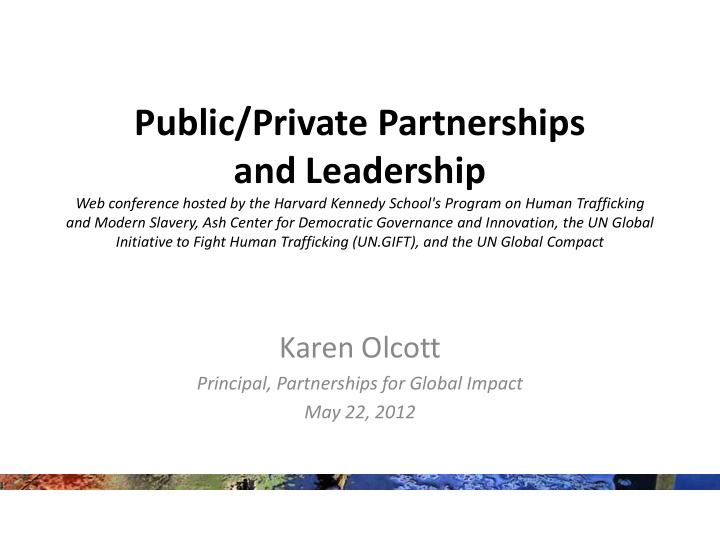



Public/Private Partnerships and Leadership Web conference hosted by the Harvard Kennedy School's Program on Human Trafficking and Modern Slavery, Ash Center for Democratic Governance and Innovation, the UN Global Initiative to Fight Human Trafficking (UN.GIFT), and the UN Global Compact Karen Olcott Principal, Partnerships for Global Impact May 22, 2012
On My Mind History of Movements that changed culture • Tipping Point of Human Trafficking after 12 year on-ramp • – The “Popcorn” Effect, the “Spinnaker” Effect Different constituents, intentional roles • – NAAG Presidential Initiative – Corporate efforts beginning – Publicity, media, movies, culture – Strategic leadership Challenge for the public & private sectors • – Business mindset, diligence and structure – Prioritized approach, infrastructure, roadmap, goals, sustainability Need Priorities that provide value for both public & private sectors • Need Leadership that is strategic, unifying and intentional •
A Look at History Major cultural shifts – looking at the “triggers” in social movements • – Civil Rights movement – personal, political, equality, human – Bullying movement – role & impact on schools – Seatbelts movement – requirement in cars, laws – No Smoking movement – impact on businesses, personal health, laws – Domestic Violence movement – laws, services, – Hiring Veterans movement – human, impact on business Usually multiple sectors involved, public outcry, alignment on • purpose that overrides the differences, persistence Individual leaders as catalysts • – Some of the most powerful cultural forces of activism and engagement, may be difficult to coordinate with, predict, or even define
Tipping Point for Human Trafficking Obligations since 2000 • The UN enforces the international standards (Palermo Protocol) across 117 countries, and – US enacted the Trafficking Victims Protection Act (TVPA) Trafficking in Persons Report (TIP) reports 184 countries in 2011 – Movement “infrastructure” developing, but disjointed & weary • Public sector or government services have created laws, pathways, agencies – Nonprofits have expertise and importance, but limited scope; grassroots, etc. – Private sector needs to discover and articulate the value, their capabilities – “Popcorn” interest, “Spinnaker” roles – Create headwinds – scale the message – inspire responsibility - innovation – What’s needed? Who is best to effect? How to measure? Progress? – Different constituents, need for intentional roles, cross-sector collaboration, master plan, • roadmap
Sectors Finding Their Roles Leadership from both sectors: convene, partner, fund, influence • Private: Businesses part of the solution, value in their expertise, brand, access to consumers • The Code, BCAT, B.E.S.T, EICC, CA Transparency Act, Coca-Cola Forum on Labor – Microsoft - Digital Crimes Unit work, RFP on HT research, responsible sourcing – Google - $12M grant to key nonprofits – Harvard Carr, USC Annenberg - white papers, models, convening – JP Morgan - “Follow the Money, financial data mining – Student/Faculty Curricula - college and secondary school level – Media impact – movies, journalism, awareness – Public: Federal and State Agencies, set agenda, directional, governmental affairs, cross- • divisional influence Law enforcement, legislation, prosecution – Attorneys General, ABA, FBI, DOJ, ILO, etc. –
NAAG Presidential Initiative National Association of Attorneys General (NAAG) represent all 50 • States, with great convening power and influence – Main legal advisor to government, law enforcement, responsibility for public prosecutions WA Attorney General Rob McKenna as key voice and leader • 2011-2012 Presidential Initiative with 4 buckets of Action • 1. Making the Case 2. Holding Traffickers Accountable 3. Mobilizing Communities to Care for Victims 4. Public Awareness and Issue Advocacy Multi-year focus, achievable goals, deliberate and action-oriented • activities that put a stake in the ground
Technology Partnerships “…world's largest software company, we create social and economic impact wherever we do business…accountable to shareholders, customers, employees, business partners... …we are committed to operating responsibly and sustainably. “ 90,000 employees in 100 countries, $246B market cap • Huge Consumer & Enterprise reach globally, Corporate Citizenship • Digital Crimes Unit, child exploitation crimes & malicious software crimes • 2009 partnership with NCMEC, & Dartmouth, developed PhotoDNA, image-matching – technology to find and remove worst images of child pornography from the internet Used on Bing, SkyDrive, Hotmail; free to Facebook and other online services – Focus on what they do best, responsibility, leader in industry, influence • 1. Technology and Research expertise 2. Tools for education, internet distribution, training 3. Ability to detect, report, take-down 4. Influence public & private sectors 5. Human Trafficking is “porous” issue
Challenges in Social Impact Work Public-Private partnerships require innovation, focus on specific tasks • that leverage their core business, and create new value – Can corporations quantify the $$ value of brand, of leverage their product/services, appropriate influence, is there a top-down focus? – “Porous” issue – where is there risk, benefit, context, why this cause? Human Trafficking is not widely understood, “scary” - “risky” • – Supply chain issues are difficult to track, correct – Employee code of conduct difficult to language & enforce – Risk to brand association? Infrastructure that’s effective? Scale? – Do employees care? Do consumers care? Does management/board care? Expertise often on private side, but they will not drive the vision • – Technology, tracking, data-mining, funding, influence
Priorities for Impact Foster a collaborative & synchronized “Movement” theme • Create more effective Vocabulary/Language about the issue • – Is focus on demand, victim-centric, labor, sex trafficking, moving target? – Identify the gaps & needs coherently in an inclusive “sector-focused” plan – Focus on innovation, ideal public-private partnerships, master plan – Partition or ally deliberately with other agencies focused on women, violence, education – Rally against singular “Zero Tolerance” Drive more “C-Suite” approach, diligence, discipline & value through a • comprehensive business-focused roadmap Leadership: Prioritize actionable, measurable and impactful results • through intentional public/private partnerships Innovation creates influence, funding, intention, cultural change
Karen@KarenOlcott.com www.KarenOlcott.com LinkedIn, Twitter, Facebook 425-641-1124
Recommend
More recommend